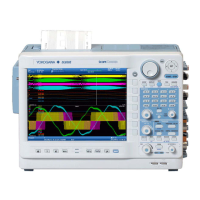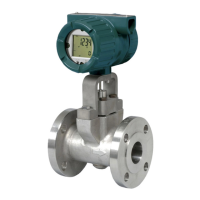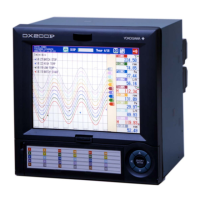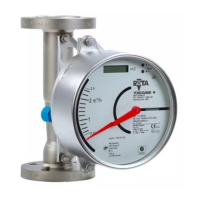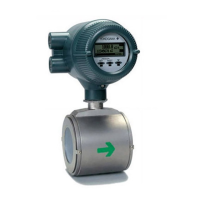2-14
IM 701210-05E
2.2 Setting the Horizontal and Vertical Axes
Strain Measurement <Section 5.17>
Strain can be measured by connecting a strain gauge bridge (bridge head) or a strain
gauge transducer to the strain module.
Relationship between the Strain (µSTR) and the Transducer Output (mV/V)
The DL750/DL750P allows the unit to be changed between “the strain unit (µSTR: ×10
–6
strain)” and “the output unit of the strain gauge transducer (mV/V)
1
.” The default setting
is “strain (µSTR).” The following relationship exists between µSTR and mV/V.
(mV/V) = 0.5×(µSTR)/1000
Example
500 (µSTR) -> 0.5×500(µSTR)/1000 = 0.25 (mV/V)
Gauge Factor (K) when mV/V Is Selected
K = 2
You can set the gauge factor to an arbitrary value on the DL750/DL750P. However, if
there are no specifications on the strain gauge transducer, set K to 2.
If K is not 2, e is derived within the DL750/DL750P using the following equation.
e = (4/K)×(V/E)
e: Measured value of the strain gauge transducer [mV/V]
V: Voltage measured on the bridge [V]
E: Voltage applied to the bridge [V]
K: Gauge factor
When you switch the unit, the unit of all related parameters of the channel is switched
accordingly.
• Upper and lower limits
• Trigger level
• Values of automated measurement of waveform parameters and cursor
measurements, etc.
In addition, the 701271 Strain Module (STRAIN_DSUB) supports shunt calibration.
2
1. Unit corresponding to the output of the strain gauge transducer. A value expressing the
transducer output per volt applied to the bridge in mV. You can set the bridge voltage
(excitation: voltage applied to the bridge) from 2 V, 5 V, and 10 V. However, since the mV/V
value is a converted value, the measured value is basically constant.
2. Shunt calibration refers to the act of correcting the gain of the strain measurement by
connecting a known resistance (shunt calibration resistance) to the strain gauge in parallel.
For a description of the basic defining equation of strain, see appendix 10. For details on
shunt calibration, see appendix 11.
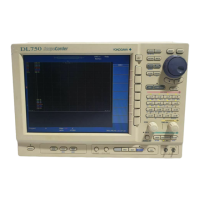
